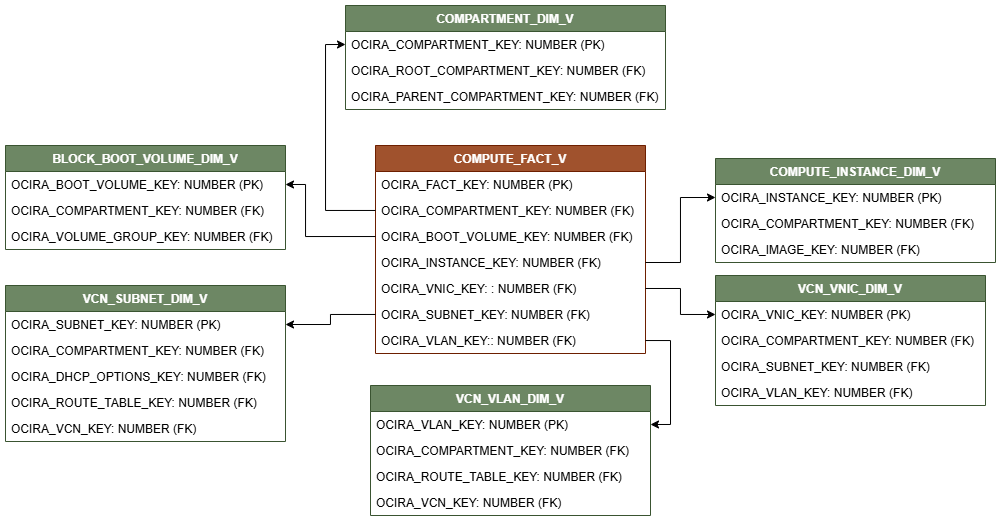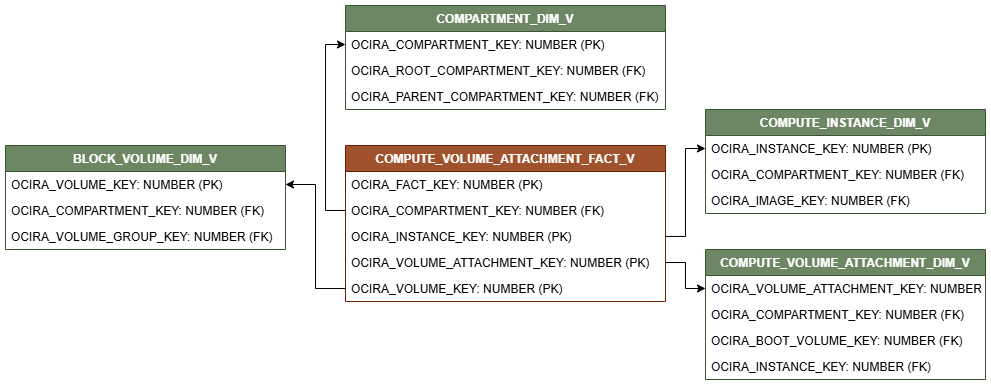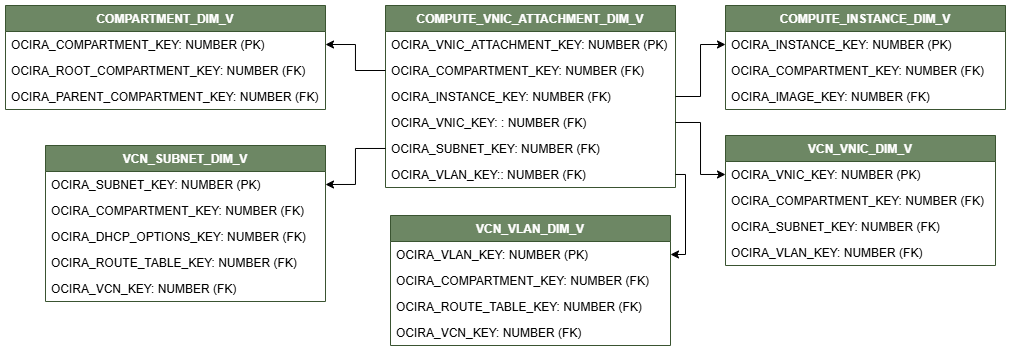Reference for Compute
This guide lists the predefined objects in Resource Analytics for Oracle Compute. You can find information about views, entity relationships, subject areas and sample queries.
Views
This section provides information about views within Resource Analytics Compute and their columns, data types, keys, and the referred view and column names. The following views are available:
| Name | Description |
|---|---|
| COMPUTE_BOOT_VOLUME_ATTACHMENT_DIM_V | This view stores information about the attachments between a boot volume and an instance. |
| COMPUTE_INSTANCE_DIM_V | This view stores information about compute instances and their properties. |
| COMPUTE_VNIC_ATTACHMENT_DIM_V | This view stores information on the attachments between VNICs and instances. |
| COMPUTE_VOLUME_ATTACHMENT_DIM_V | This view stores information on the base object for all types of attachments between a storage volume and an instance. |
| COMPUTE_FACT_V | Fact centered on instances and with associated measures for each instance: attached volumes count, attached secondary VNIC count, GPU count, memory and OCPU usage. |
| COMPUTE_VOLUME_ATTACHMENT_COMBINED_DIM_V | Denormalized view combining the data for volume and boot volume attachments. Combines data from COMPUTE_VOLUME_ATTACHMENT_DIM_V and COMPUTE_BOOT_VOLUME_ATTACHMENT_DIM_V. |
| INSTANCE_VOLUME_DETAILS_V | Denormalized view that stores information on compute instances and the boot and block volumes attached to the instance. Combines data from COMPUTE_INSTANCE_DIM_V, COMPUTE_VOLUME_ATTACHMENT_DIM_V, COMPUTE_BOOT_VOLUME_ATTACHMENT_DIM_V, and BLOCK_VOLUME_DIM_V. |
| COMPUTE_VOLUME_ATTACHMENT_FACT_V | Fact for attachments between storage volumes and compute instances. Measures include attachment count, instance GPU count, instance memory usage in MB, instance OCPU usage and volumes size in GB. |
| COMPUTE_IMAGE_DIM_V | This view stores information about boot disk images for starting an instance. |
The suffixes in the view names specify the view type:
- FACT_V: Fact
- DIM_V: Dimension
- COMBINED_DIM_V and _V: Denormalized view
Relationship Diagram
This section provides diagrams that define the logical relationship of a fact view with different dimension view.
The contents of each view and their relationships are listed in the following file: compute views.
This diagram shows the relationship of the Compute fact view with different dimension views.


Relationships exist among dimensions. Dimensions can be joined directly to each other. These diagrams show the relationship between dimension views.



COMPUTE_IMAGE_DIM_V

Sample Queries
Sample queries for Compute.
SELECT *
FROM OCIRA.COMPUTE_INSTANCE_DIM_V
WHERE SHAPE = 'VM.Standard.E4.Flex'SELECT ID
FROM OCIRA.COMPUTE_INSTANCE_DIM_V
WHERE SHAPE = 'VM.Standard.E4.Flex';SELECT CI.ID AS INSTANCE_ID, CI.DISPLAY_NAME AS INSTANCE_NAME, VA.ATTACHMENT_TYPE
FROM OCIRA.COMPUTE_INSTANCE_DIM_V CI
JOIN OCIRA.COMPUTE_VOLUME_ATTACHMENT_DIM_V VA ON CI.ID = VA.INSTANCE_ID
WHERE VA.ATTACHMENT_TYPE IN ('ISCSI', 'PARAVIRTUALIZED');SELECT *
FROM OCIRA.COMPUTE_INSTANCE_DIM_V
WHERE LIFECYCLE_STATE = 'Terminated';SELECT CI.ID AS COMPUTE_INSTANCE_ID, CV.VOLUME_ID, CI.LIFECYCLE_STATE
FROM OCIRA.COMPUTE_INSTANCE_DIM_V CI
JOIN OCIRA.COMPUTE_VOLUME_ATTACHMENT_DIM_V CV ON CI.ID = CV.INSTANCE_ID
WHERE CI.LIFECYCLE_STATE != 'Running'SELECT VA.ID AS INSTANCE_ID, VA.BOOT_VOLUME_ID, B.DISPLAY_NAME AS BOOT_VOLUME_DISPLAY_NAME,
B.LIFECYCLE_STATE AS BOOT_VOLUME_LIFECYCLE_STATE, B.SIZE_IN_GBS
FROM OCIRA.COMPUTE_BOOT_VOLUME_ATTACHMENT_DIM_V VA
JOIN OCIRA.BLOCK_BOOT_VOLUME_DIM_V B ON VA.OCIRA_BOOT_VOLUME_KEY = B.OCIRA_BOOT_VOLUME_KEY;SELECT VA.ID AS INSTANCE_ID, VA.COMPARTMENT_ID AS INSTANCE_COMPARTMENT, VA.VOLUME_ID,
B.DISPLAY_NAME AS VOLUME_DISPLAY_NAME, B.LIFECYCLE_STATE AS VOLUME_LIFECYCLE_STATE,
B.SIZE_IN_GBS
FROM OCIRA.COMPUTE_VOLUME_ATTACHMENT_DIM_V VA
JOIN OCIRA.BLOCK_VOLUME_DIM_V B ON VA.OCIRA_VOLUME_KEY = B.OCIRA_VOLUME_KEY;SELECT VA.INSTANCE_ID, VA.SUBNET_ID, S.CIDR_BLOCK AS SUBNET_CIDR_BLOCK,
S.DISPLAY_NAME AS SUBNET_DISPLAY_NAME, S.LIFECYCLE_STATE AS SUBNET_LIFECYCLE_STATE,
VA.VLAN_ID, V.CIDR_BLOCK AS VLAN_CIDR_BLOCK, V.DISPLAY_NAME AS VLAN_DISPLAY_NAME,
V.LIFECYCLE_STATE AS VLAN_LIFECYCLE_STATE,VA.VNIC_ID,
VN.DISPLAY_NAME AS VNIC_DISPLAY_NAME, VN.LIFECYCLE_STATE AS VNIC_LIFECYCLE_STATE
FROM OCIRA.COMPUTE_VNIC_ATTACHMENT_DIM_V VA
LEFT JOIN OCIRA.VCN_SUBNET_DIM_V S ON VA.OCIRA_SUBNET_KEY = S.OCIRA_SUBNET_KEY
LEFT JOIN OCIRA.VCN_VLAN_DIM_V V ON VA.OCIRA_VLAN_KEY = V.OCIRA_VLAN_KEY
LEFT JOIN OCIRA.VCN_VNIC_DIM_V VN ON VA.OCIRA_VNIC_KEY = VN.OCIRA_VNIC_KEY;SELECT INSTANCE_ID, BOOT_VOLUME_ID, VOLUME_ID
FROM OCIRA.INSTANCE_VOLUME_DETAILS_V
WHERE INSTANCE_ID = <insert instance ID>;SELECT TAG_TYPE, TAG_KEY_NAME, TAG_VALUE
FROM OCIRA.TAGS_DIM_V
WHERE RESOURCE_TYPE = 'instance';Data Lineage
The Customer Experience Semantic Model Lineage spreadsheet and Metric Calculation Logic spreadsheet for Compute provides an end-to-end data lineage summary report for physical and logical relationships in your data.
For more information, see Data Lineage.
Subject Areas
This section provides information on the subject areas with data you maintain in Compute. These subject areas, with their corresponding data, are available for you to use when creating and editing analyses and reports. The information for each subject area includes:
-
Description of the subject area.
-
Business questions that can be answered by data in the subject area, with a link to more detailed information about each business question.
-
Job-specific groups and duty roles that can be used to secure access to the subject area, with a link to more detailed information about each job role and duty role.
-
Primary navigation to the work area that's represented by the subject area.
-
Time reporting considerations in using the subject area, such as whether the subject area reports historical data or only the current data. Historical reporting refers to reporting on historical transactional data in a subject area. With a few exceptions, all dimensional data are current as of the primary transaction dates or system date.
-
The lowest grain of transactional data in a subject area. The lowest transactional data grain decides how data are joined in a report.
-
Special considerations, tips, and things to look out for in using the subject area to create analyses and reports.